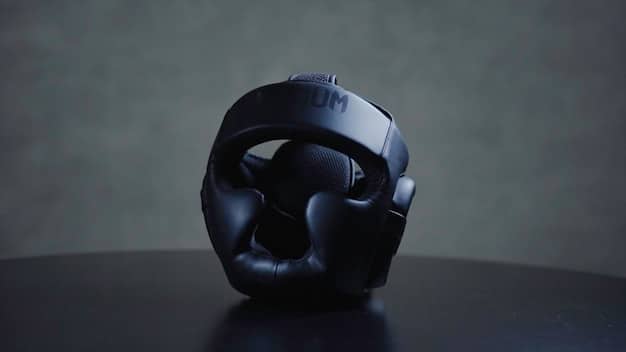Hear Every Footstep: Best Gaming Headset Upgrades for Audio Immersion

Achieving unparalleled audio immersion in gaming hinges on optimizing your headset, transforming footsteps, dialogue, and environmental cues into critical tactical advantages and enhancing narrative depth.
In competitive gaming, every sonic detail matters. From the subtle rustle of leaves that betray an enemy’s position to the distant reload of a weapon, superior audio can differentiate victory from defeat. This guide delves into how to Hear Every Footstep: The Best Gaming Headset Upgrades for Immersive Audio, transforming your gaming sound experience from merely adequate to truly extraordinary.
Why Your Gaming Headset is Crucial for Immersion and Performance
Beyond visual fidelity and frame rates, audio forms a critical pillar of gaming immersion. A high-quality gaming headset does more than just transmit sound; it crafts a soundscape that pulls you into the virtual world, making you feel every explosion, hear every whisper, and anticipate every movement. This is particularly vital in genres like first-person shooters, horror, and open-world adventures where spatial audio cues directly impact gameplay.
The distinction between a generic headset and a purpose-built gaming headset lies in several key areas. Gaming headsets are often designed with specific acoustic profiles that prioritize clear communication and the accurate reproduction of in-game effects. This means not just louder sounds, but sounds that are clearer, more defined, and correctly positioned within a virtual 3D space. The result is an environment where you are truly part of the action, rather than just observing it.
Enhanced Situational Awareness
One of the primary advantages of a premium gaming headset is improved situational awareness. Knowing where an enemy is before they appear on screen can give you a significant tactical edge. Better headsets achieve this through advanced audio technologies like virtual surround sound, which creates the illusion of sound originating from multiple directions around you, even with only two physical drivers.
- Pinpoint Enemy Locations: Accurately identify the direction of enemy footsteps, gunshots, or ability cues.
- React Faster: Quicker response times based on precise audio feedback.
- Avoid Ambushes: Hear subtle movements that signal impending threats.
For competitive players, this can translate directly into higher kill-death ratios and more victories. In single-player immersive experiences, it deepens the connection to the game world, allowing for a more profound and emotional journey.
Communication Clarity and Comfort
Effective team communication is paramount in multiplayer games. A superior gaming headset not only provides excellent incoming audio but also ensures your outgoing voice is crystal clear. This often involves advanced microphone technology, including noise cancellation features that filter out background distractions, allowing your teammates to hear you without interference. Comfort is another often-overlooked aspect.
Long gaming sessions demand a headset that can be worn for hours without causing discomfort. This means lightweight designs, breathable earcups, and adjustable headbands. Many high-end headsets invest heavily in ergonomic design, using materials that are both durable and gentle on the skin, preventing fatigue and allowing players to stay focused on the game.
Ultimately, upgrading your gaming headset isn’t just about sound quality; it’s about investing in your overall gaming experience. It’s about gaining a competitive edge, enhancing immersion, and ensuring that every session is as enjoyable and comfortable as possible. The right headset transforms audio from a mere background element into a vital component of your gameplay strategy and enjoyment.
Understanding Audio Technologies: Stereo, Surround Sound, and Beyond
The journey to truly immersive gaming audio begins with understanding the core technologies that deliver sound to your ears. While traditional stereo sound forms the foundation, advancements in virtual and true surround sound aim to replicate the auditory experience of the real world, where sounds come from all directions. Deciphering these technologies is crucial for making an informed decision about your next headset upgrade.
Stereo Audio: This is the most basic form of sound reproduction, using two channels – left and right. Most entry-level headsets utilize stereo audio. While perfectly adequate for music and general media consumption, its ability to accurately portray spatial awareness in gaming is limited. You can tell if a sound is coming from your left or right, but not necessarily if it’s in front, behind, or above you.
Virtual Surround Sound: This technology simulates a multi-speaker setup using only two headphone drivers. It achieves this by applying complex digital signal processing (DSP) algorithms to stereo audio signals. The most common implementations are 7.1 virtual surround sound, but some headsets also offer 5.1. While not “true” surround sound with discrete drivers for each channel, virtual surround sound can create a convincing illusion of depth and directionality, significantly improving spatial awareness in games.
The effectiveness of virtual surround sound can vary widely between headsets, depending on the quality of their DSP and driver design. Some implementations might sound tinny or artificial, while others can be incredibly convincing, allowing you to pinpoint enemy footsteps with surprising accuracy. Many gaming headsets offer software-based virtual surround sound, enabling you to toggle it on or off and customize settings.
True Surround Sound vs. Virtual Surround Sound
True Surround Sound (often 5.1 or 7.1): These headsets feature multiple discrete audio drivers within each earcup, mirroring the setup of a physical home theater system. For example, a 5.1 true surround sound headset would have at least five miniature speakers in each earcup, dedicated to specific channels (front left, front right, center, rear left, rear right, and a subwoofer for bass). The idea is to provide discrete audio signals to each driver, offering a more genuine sense of directionality.
- Pros: Potentially more accurate spatial audio, distinct channel separation.
- Cons: Can be heavier, more expensive, and may require more power. Not always as effective as hyped, as the small drivers are very close to the ear.
- Current Trend: True surround sound headsets are becoming less common as virtual surround sound technology has advanced significantly, often offering comparable or superior performance with fewer drawbacks.
Most modern high-end gaming headsets lean towards refined virtual surround sound implementations, often bundled with sophisticated software suites. These suites allow users to calibrate the virtual soundstage, adjust equalizer settings, and save profiles for different games or applications. Features like “footstep boost” or “voice clarity” can be tailored to specific game genres, optimizing the audio profile for competitive play or cinematic immersion.

Furthermore, audio codecs play a vital role. High-resolution audio support can provide a wider dynamic range and finer detail, though this often depends on the source audio itself. Understanding the nuances of these technologies will empower you to choose a headset that not only sounds good but genuinely enhances your gaming performance and immersion by allowing you to hear every critical sound cue.
Wired vs. Wireless: Connectivity Choices and Their Impact
One of the most fundamental decisions when upgrading your gaming headset is choosing between wired and wireless connectivity. Both options present distinct advantages and disadvantages, impacting everything from audio quality and latency to convenience and power consumption. Understanding these trade-offs is essential for selecting the right headset for your personal gaming setup and preferences.
Wired Headsets: Traditionally, wired headsets have been the go-to choice for serious gamers. They connect directly to your PC or console via 3.5mm jacks, USB-A, or USB-C. Their primary allure lies in their inherent reliability and lack of latency.
- Zero Latency: Audio signals are transmitted instantaneously, without any delay. This is crucial for competitive gaming where even a few milliseconds of lag can impact performance.
- Consistent Audio Quality: Wired connections generally provide a more stable and higher-fidelity audio signal, less susceptible to interference or signal degradation.
- “Plug-and-Play” Reliability: No batteries to charge, no pairing issues, simply connect and play.
- Cost-Effective: Often, equally featured wired headsets are more affordable than their wireless counterparts.
However, wired headsets come with the obvious limitation of their cables. Cables can restrict movement, tangle, and potentially become damaged over time. For gamers who frequently move or play in a living room setup, a cable can be a significant annoyance. Good cable management can mitigate some of these issues, but the physical tether remains.
Wireless Headsets: The convenience of wireless freedom has made these headsets increasingly popular. They typically connect via a dedicated 2.4GHz USB dongle or Bluetooth. While early wireless headsets struggled with latency and audio quality, modern technology has significantly narrowed this gap.
- Unrestricted Movement: Freedom to move around your gaming space without tangling wires.
- Clutter-Free Setup: A cleaner desk or entertainment area without visible cables.
- Cross-Platform Compatibility: Many wireless headsets offer versatile connectivity options (e.g., 2.4GHz for consoles/PC, Bluetooth for mobile devices).
Despite their advancements, wireless headsets still have some inherent considerations. Latency, while greatly reduced, can still exist, particularly with Bluetooth connections. For critical competitive play, even minimal latency might be noticeable. Battery life is another factor; wireless headsets require regular charging, and running out of power mid-game can be frustrating. Interference from other wireless devices (Wi-Fi routers, other peripherals) can also occasionally degrade audio quality or cause dropouts, though this is less common with dedicated 2.4GHz connections.
The choice between wired and wireless ultimately depends on your priorities. If absolute minimal latency and consistent, uncompromised audio are paramount for competitive play, wired remains a strong contender. If convenience, freedom of movement, and a clean setup are your top concerns, modern wireless headsets offer an excellent, often near-parity, experience. Many high-end wireless headsets also offer the option to switch to a wired connection if desired, providing the best of both worlds.
Microphone Quality: Communicating Clearly with Your Team
While often overshadowed by sound output, the microphone on a gaming headset is equally vital, especially for multiplayer experiences. Effective team communication can make or break a game, and a poor microphone can lead to misunderstandings, frustration, and ultimately, a less enjoyable gaming session. Upgrading your headset often means a significant leap in microphone quality, allowing your teammates to hear you loud and clear, even amidst intense in-game action.
Gaming headset microphones vary widely in type and quality. Most fall into one of two categories: boom microphones or integrated microphones. Boom mics, which extend from the earcup towards your mouth, generally offer superior clarity and noise cancellation due to their proximity to the sound source. Integrated microphones, often found on more casual or portable headsets, are smaller and less obtrusive but can pick up more ambient noise.
Key Microphone Features to Look For:
- Noise Cancellation: This is perhaps the most crucial feature for a gaming microphone. Good noise cancellation actively filters out background sounds like keyboard clicks, fan noise, or even conversations in the same room. This ensures your voice is isolated and transmitted clearly to your teammates. Some advanced headsets use AI-powered noise reduction for even better performance.
- Directional Pickup (Unidirectional/Bidirectional): Most gaming microphones are unidirectional (or cardioid), meaning they pick up sound primarily from one direction – your mouth – while rejecting sounds from other angles. Bidirectional microphones pick up sound from two directions, which can be useful in specific streaming setups, but less common for typical gaming.
- Sidetone/Mic Monitoring: This feature allows you to hear your own voice through your headset, preventing you from shouting unknowingly and helping you modulate your volume naturally.
- Mute Functionality: An easy-to-access mute button or flip-to-mute boom is essential for privacy and avoiding accidental transmissions.

Beyond these features, the inherent quality of the microphone capsule itself, along with the digital signal processing (DSP) applied by the headset, determines the richness and naturalness of your voice. Cheaper microphones might sound tinny or distorted, while high-quality ones provide a full-bodied, broadcast-like sound.
For streamers and content creators, microphone quality takes on an even greater importance. While a dedicated standalone microphone is often preferred for professional-grade audio, a top-tier headset mic can serve as an excellent all-in-one solution for casual streaming or as a reliable backup. Considering how often you communicate in-game, investing in a headset with a robust and clear microphone is just as vital as investing in its sound output capabilities to truly elevate your competitive edge and overall gaming pleasure.
Comfort and Durability: Essential for Long Gaming Sessions
When it comes to gaming headsets, sound quality and microphone clarity are undoubtedly paramount, but their importance pales if the headset is uncomfortable to wear for extended periods. Comfort and durability are not luxuries; they are fundamental requirements for any serious gamer, directly impacting both the enjoyment and length of your gaming sessions. An uncomfortable headset can lead to fatigue, headaches, and ultimately, a disrupted gaming experience, while a fragile one might not withstand the rigors of regular use.
Ergonomics for Extended Wear: Gaming sessions can stretch for hours, demanding a headset that feels almost imperceptible. Key factors contributing to comfort include:
- Weight: Lighter headsets reduce strain on the neck and head. Materials like aluminum or lightweight plastics are often used in premium models to shed grams without compromising on structural integrity.
- Clamping Force: The pressure the earcups exert on your head. Too tight, and it causes discomfort; too loose, and it compromises sound isolation and stability. A balanced clamping force is crucial.
- Earcup Material: Velour, memory foam, and hybrid materials are common. Velour is highly breathable, preventing sweat buildup. Memory foam conforms to your head shape, providing excellent sealing and comfort. Hybrid options attempt to combine the best of both.
- Headband Design: Often features generous padding and adjustability. Some use a “suspension” design where an inner band distributes weight more evenly, reducing pressure points on the crown of the head.
The choice of earcup material can also affect sound isolation and breathability. Leatherette or protein leather earcups offer better passive noise isolation but can lead to more sweat buildup. Velour, while less isolating, is significantly more breathable. Many high-end headsets offer interchangeable earcups, allowing users to customize their experience for different situations or preferences.
Building to Last: Durability Aspects
A gaming headset is an investment, and like any investment, you want it to last. Durability goes beyond just surviving accidental drops; it encompasses the quality of materials, the design of moving parts, and how well it stands up to daily wear and tear. Points to consider regarding durability include:
- Frame Construction: Headsets with metal frames (e.g., aluminum, steel) are significantly more robust than those made entirely of plastic. Metal adds weight but provides superior resilience against twisting and impacts.
- Cable Quality (for wired models): Braided cables are more resistant to tangles and fraying. Detachable cables are a huge plus, as a damaged cable can be easily replaced without needing to buy a new headset.
- Hinge and Pivot Points: These are common failure points. Look for headsets with reinforced hinges or minimal moving parts to reduce the risk of breakage.
- Overall Build Quality: Pay attention to the fit and finish. Are there any creaking sounds when flexing the headset? Does it feel solid or flimsy?
Ultimately, a comfortable and durable headset allows you to game for longer periods, immerse yourself fully without distraction, and ensures your investment will continue to serve you well. Prioritizing these aspects alongside audio and microphone performance will lead to a more satisfying and enduring gaming experience.
Software and Customization: Tailoring Your Audio Experience
Modern gaming headsets are more than just plug-and-play audio devices; many are sophisticated pieces of hardware complemented by powerful software suites. This software allows for a deep level of customization, enabling users to fine-tune their audio experience, calibrate their microphones, and even integrate with game-specific profiles. Understanding the capabilities of these software platforms is crucial for unlocking the full potential of a high-end gaming headset.
Equalizer (EQ) Settings: One of the most common and powerful customization options is the equalizer. An EQ allows you to adjust the volume of specific frequency ranges (bass, mids, treble) to suit your preferences or the demands of a particular game. For instance:
- Competitive Gaming EQ: Often involves boosting mid-range frequencies to emphasize footsteps and dialogue while slightly reducing bass to prevent explosions from overwhelming critical audio cues.
- Immersive EQ: May involve a “V-shaped” EQ, boosting bass and treble for more impactful explosions and clearer highs in cinematic games.
- Music/Movies: Different EQs can be saved for non-gaming content, optimizing the headset for media consumption.
Many software suites come with pre-set EQ profiles for common game genres (e.g., FPS, RPG, racing) or even specific game titles. Users can typically create and save their own custom profiles, switching between them with ease.
Virtual Surround Sound Calibration
For headsets offering virtual surround sound, the software often provides tools to calibrate the virtual soundstage. This might involve adjusting the perceived distance of virtual speakers, their angle, or even their individual volume. A well-calibrated virtual surround sound system can dramatically improve spatial awareness, making it easier to pinpoint the exact location of enemy movements or environmental sounds. Some software also includes “head-tracking” features, though these are less common in consumer-grade gaming headsets.
Microphone Customization: Beyond basic volume control, headset software can offer advanced microphone settings:
- Noise Gate: Sets a threshold below which ambient sounds are ignored, preventing static or background noise from being transmitted when you’re not speaking.
- Compression: Evens out your voice volume, making quiet whispers louder and loud shouts quieter, ensuring a consistent audio level for your teammates.
- Sidetone/Mic Monitoring: Controls the volume at which you hear your own voice through the headset.
- Voice Modulators: Some software includes fun (though less practical) voice changers for streaming or casual play.
Game Integration and Profiles: Advanced software may integrate directly with popular games, automatically applying specific audio profiles when a game launches. This ensures optimal audio settings without manual adjustments. Cloud-based profile storage allows users to save and access their custom settings across different devices or even share them with friends.
While software enhances the feature set, it’s worth noting that some users prefer simpler, driver-less headsets for “plug-and-play” convenience. However, for those who seek to truly tailor their audio experience, minimize ambient noise, and gain a competitive edge, the software and customization options of a premium gaming headset are invaluable additions, allowing you to fine-tune sound to truly hear every footstep.
Top Features to Look for in a Premium Gaming Headset
Choosing a premium gaming headset is about more than just a brand name; it’s about a combination of features that elevate your auditory experience. To truly “hear every footstep” and immerse yourself, you need to look beyond marketing hype and focus on the technical specifications and design choices that deliver tangible benefits. Here are the top features that distinguish a good gaming headset from a truly excellent one.
High-Fidelity Audio Drivers: The heart of any headset lies in its drivers. Look for larger drivers (typically 50mm or larger) as they generally offer a wider frequency response and more impactful bass. More importantly, consider the quality of the drivers. Neodymium magnets and well-engineered diaphragms contribute to cleaner, more accurate sound reproduction across the entire audio spectrum. Some high-end headsets employ planar magnetic drivers, known for their exceptional clarity and detail, though these are often more expensive.
Advanced Virtual Surround Sound (with Software Suite): As discussed, virtual surround sound is key for spatial awareness. Seek out headsets that not only claim “7.1 surround sound” but also provide robust software for customizing and calibrating it. The ability to fine-tune virtual speaker positions or apply directional audio enhancements can make a significant difference in pinpointing enemy locations.
Connectivity Options and Battery Life:
- Low-Latency Wireless: For wireless headsets, a dedicated 2.4GHz RF connection is preferred over Bluetooth for gaming due to its lower latency and stronger signal.
- Long Battery Life: If going wireless, aim for headsets offering 20-30 hours or more of battery life on a single charge to avoid mid-session interruptions. Fast charging capabilities are a bonus.
- Hybrid Connectivity: The best wireless headsets often include the option to connect via a 3.5mm cable, allowing for use even when the battery dies or for compatibility with devices without USB ports.
Exceptional Microphone with Noise Cancellation: A clear microphone is non-negotiable for team-based games. Look for boom microphones with active noise cancellation or passive background noise reduction. Features like flip-to-mute, sidetone (mic monitoring), and robust software controls for gain, noise gates, and compression indicate a high-quality mic setup.
Premium Build Materials and Ergonomics: Durability and comfort are critical for long-term satisfaction. Metal-reinforced headbands, high-quality plastics, and sturdy hinges enhance longevity. For comfort, prioritize breathable ear cushions (velour or hybrid materials) and memory foam padding. Adjustable headbands and swivel earcups ensure a personalized fit that reduces pressure points during extended use.
Intuitive On-Ear Controls: Quick access to volume adjustments, mic mute, and surround sound toggles directly on the earcups is immensely convenient. tactile buttons and well-placed dials can prevent you from fumbling with software settings during critical moments.
By focusing on these key features – superior audio drivers, advanced surround sound, reliable low-latency connectivity, a crystal-clear microphone, durable yet comfortable construction, and intuitive controls – you can confidently select a gaming headset that not only provides an immersive audio experience but also gives you a distinct competitive edge.
Caring for Your Gaming Headset: Longevity and Performance Tips
Investing in a premium gaming headset is only the first step. To ensure it continues to deliver pristine audio and reliable performance for years to come, proper care and maintenance are essential. Neglecting your headset can lead to degraded sound quality, a shortened lifespan, and eventual costly replacements. By adopting a few simple habits, you can significantly extend the life of your audio companion and maintain its top-tier performance.
Proper Storage Is Key: When not in use, your headset should have a designated spot. Avoid leaving it tangled on your desk or tossed aside. A headset stand is an excellent investment, keeping it off the desk, preventing cable tangles, and reducing the risk of accidental damage. If you frequently travel with your headset, a hard-shell carrying case will protect it from bumps, scratches, and pressure that could damage earcups or hinges.
Mind the Cables (for wired headsets): Cables are often the first point of failure for wired headsets. Avoid wrapping cables too tightly around the headset or twisting them into unnatural configurations. Use cable ties or Velcro straps to manage excess length. Never pull on the cable to unplug the connector; always grip the plug itself. If your headset has a detachable cable, considering a replacement cable after a few years can give a new lease on life to an otherwise functional headset.
Cleaning and Hygiene:
- Wipe Down Regularly: Use a soft, slightly damp cloth to wipe down the earcups and headband regularly. This removes oils, sweat, and dirt that can accumulate over time and degrade materials.
- Clean Ear Cushions: For fabric or velour earcups, a lint roller or a piece of tape can lift dust and debris. Some earcup materials can be gently hand-washed with mild soap and water (check manufacturer guidelines first). For leatherette, dry wiping is usually sufficient, with occasional use of a leather-safe cleaner.
- Microphone Care: If your microphone has a foam windscreen, periodically remove and clean it. For mesh grilles, a soft brush can gently remove dust. Avoid blowing directly into the mic as this can introduce moisture and residue.
Battery Health (for wireless headsets): Just like any rechargeable device, proper battery care extends battery life. Avoid letting the battery completely drain to 0% often, and try not to keep it plugged in and charging constantly once it’s full. Aim for a charging cycle that keeps the battery between 20-80% when possible, although modern batteries are quite resilient to varied charging habits.
Software Updates and Driver Maintenance: If your headset uses companion software, regularly check for firmware and driver updates. Manufacturers often release updates to improve performance, fix bugs, enhance sound profiles, or optimize compatibility. Keeping your software up-to-date ensures you’re getting the best possible performance and stability from your headset.
By following these simple care tips, you can significantly prolong the life and maintain the pristine performance of your high-end gaming headset, ensuring you continue to “hear every footstep” with clarity and precision for all your immersive gaming adventures.
| Key Aspect | Brief Description |
|---|---|
| 🎧 Audio Immersion | Superior headsets provide spatial audio cues crucial for competitive edge and game immersion. |
| 🔊 Audio Technology | Virtual surround sound (e.g., 7.1) simulates multi-directional audio, enhancing positional awareness. |
| 🎤 Clear Communication | High-quality microphones with noise cancellation are essential for effective team play. |
| ✨ Comfort & Durability | Lightweight designs, premium earcups, and robust construction are vital for long gaming sessions. |
Frequently Asked Questions About Gaming Headset Upgrades
▼
Wired headsets offer zero latency and consistent audio quality, making them ideal for competitive players who demand instantaneous sound. Wireless headsets provide freedom of movement and a decluttered setup, with modern models greatly reducing latency, though a minute difference might still be present, usually not noticeable to most users.
▼
Virtual surround sound technology simulates a multi-speaker setup, creating the illusion that sounds are coming from various directions around you. This spatial audio helps you pinpoint enemy footsteps, gunshots, and other critical sound cues, giving you a tactical advantage by indicating their precise location in the game world.
▼
Absolutely. A high-quality microphone with good noise cancellation ensures your voice is transmitted clearly to your teammates, even amidst background noise. Clear communication is crucial for coordinating strategies, calling out enemy positions, and fostering good teamwork, making it as important as good audio output in multiplayer games.
▼
Key comfort features include lightweight design, balanced clamping force, and premium earcup materials like breathable velour or soft memory foam. Adjustable headbands and suspension systems also help distribute weight evenly, preventing pressure points and allowing you to game for extended periods without discomfort or fatigue.
▼
Headset software allows for extensive customization, including equalizer settings to tailor audio profiles for different games or media, virtual surround sound calibration, and advanced microphone settings like noise gates and compression. These tools enable you to fine-tune your audio and communication for optimal performance and immersion in any scenario.
Conclusion
Upgrading your gaming headset is more than a simple acquisition; it’s a strategic enhancement of your entire gaming ecosystem. By focusing on superior audio technologies, crystal-clear communication, unmatched comfort, and smart customization through dedicated software, you unlock an auditory advantage that transforms every session. The ability to precisely “hear every footstep” not only elevates your competitive play but also deepens your immersion into the incredibly rich soundscapes game developers craft. Choose wisely, care for your investment, and prepare to perceive a new dimension of your favorite virtual worlds.





